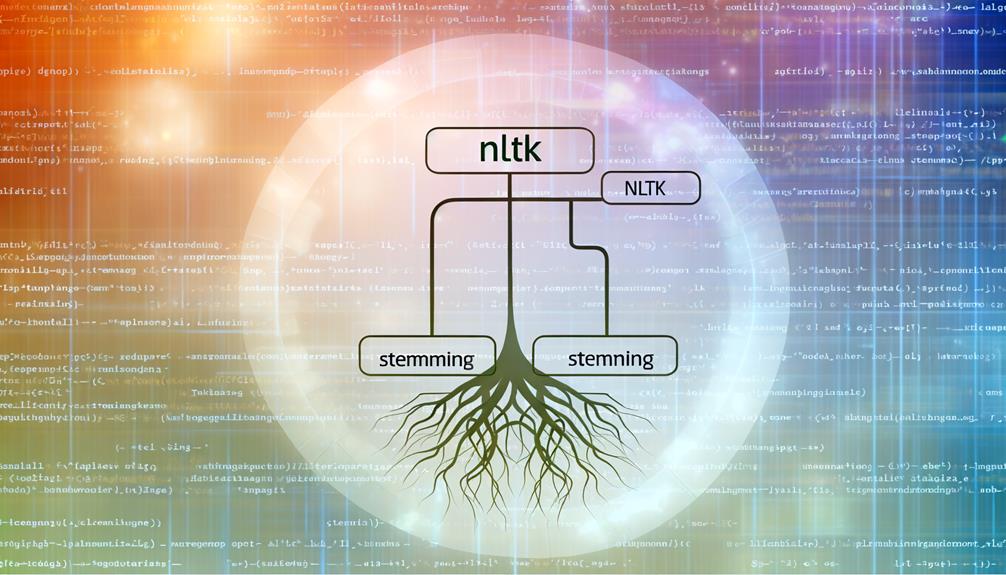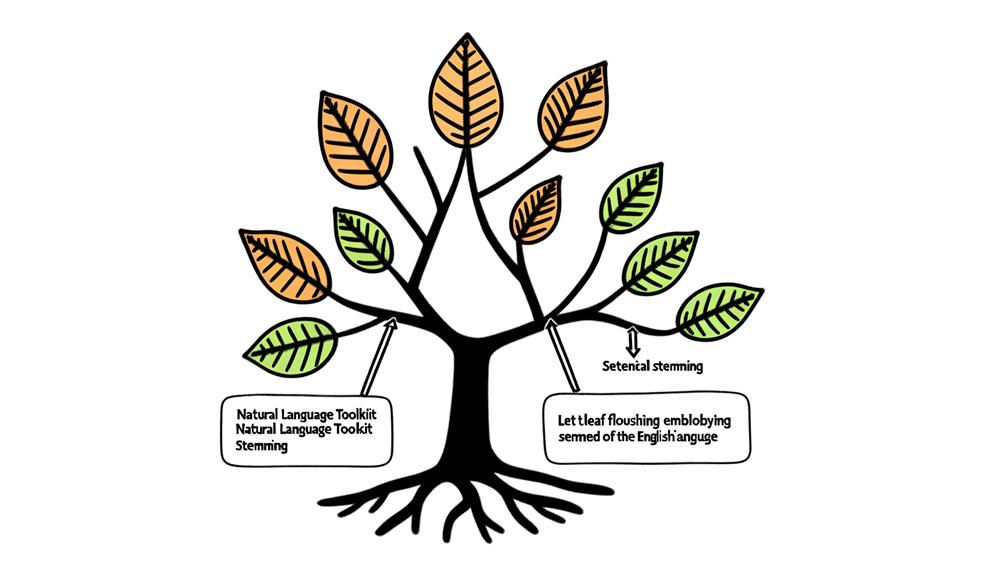To stemwords using NLTK or Natural Language Tool Kit, one must first import NLTK into their Python environment, subsequently importing the desired stemmer, for example, PorterStemmer. After initializing the stemmer, one can stem words by calling the stem() function of the stemmer object, passing a word as an argument. This process essentially reduces words to their root, enhancing text analysis capabilities in natural language processing. Furthermore, the selection of stemming techniques such as Regex, Lancaster, or Snowball is significant and more nuanced understanding will provide better results in varied applications.
Key Takeaways
- Import NLTK library and instantiate a Stemmer (like PorterStemmer) in Python.
- Use the 'stem' method on the Stemmer object, passing the word to be stemmed as an argument.
- NLTK also offers other stemmers like LancasterStemmer and SnowballStemmer for diverse linguistic needs.
- For stemming a complete sentence, tokenize the sentence into words before applying the stemmer.
- Stemming is useful for pre-processing in text analysis, improving search engine optimization, and enhancing Named Entity Recognition.
Understanding NLTK Stemming
Delving into the intricate world of NLTK Stemming reveals its pivotal role in producing morphological variations of a word's root form, a process integral to linguistic morphology and information retrieval. The underlying principle of the stemming process involves removing the affixes from a word, thereby reducing it to its root or base form. This technique, central to linguistic analysis, aids in identifying the semantic core of a word, disregarding its grammatical variations. Stemming algorithms, like the PorterStemmer within NLTK, play a crucial role in numerous Natural Language Processing (NLP) tasks. They help standardize word variations, thereby enabling more accurate text classification, sentiment analysis, and information extraction. Thus, NLTK Stemming is an essential tool in the NLP toolkit, providing a foundation for deeper linguistic understanding.
Role of NLTK in SEO

Exploring the role of NLTK in SEO reveals its significant contribution to improving search engine rankings, avoiding the perception of duplicate content, and enhancing the comprehension of search engine algorithms. NLTK, through its stemming capabilities, aids in the identification of the root form of words, thereby reducing the possibility of duplicate content. Moreover, it simplifies the content for search algorithms, making it easier to understand and rank.
| Role of NLTK in SEO | Benefits of Stemming in SEO | Impact |
|---|---|---|
| Improve rankings | Reduce duplicate content | Enhance search algorithm comprehension |
| Aid in keyword optimization | Boost relevance of content | Increase website visibility |
| Enhance content readability | Simplify linguistic complexity | Improve user experience |
In essence, NLTK and its stemming capabilities play a pivotal role in SEO, making it an indispensable tool for modern digital marketing strategies.
Various NLTK Stemming Techniques

In the realm of Natural Language Processing, NLTK offers a variety of sophisticated stemming techniques that serve as powerful tools for text preprocessing and linguistic analysis. These techniques, including Regex Stemming, LancasterStemmer, and SnowballStemmer, significantly contribute to the stemming applications in NLP by reducing morphological variations to their root forms. A comparison of these stemming techniques reveals differences in their algorithm efficiency, with some offering more precision or recall. Importantly, the choice of technique can have a profound impact on text analysis, as it influences the extraction of meaningful linguistic information. In summary, NLTK's diverse stemming techniques play a vital role in text preprocessing, NLP, and linguistic analysis, underlining the importance of understanding their strengths and weaknesses.
Using PorterStemmer in NLTK

The application of PorterStemmer, a renowned stemming algorithm in NLTK, significantly streamlines the process of reducing words to their root forms, thereby enhancing the accuracy and efficiency of text analysis in Natural Language Processing (NLP). PorterStemmer, as a part of nltk's stemming efficiency, removes the commoner morphological and inflectional endings from words, leaving their base forms. This aspect is vital for a range of practical applications, from search engines to chatbots.
Here's a brief comparison of PorterStemmer's output with original words:
| Original Word | Stemmed Word |
|---|---|
| Running | Run |
| Generously | Generous |
| Happiness | Happi |
| Libraries | Librari |
| Multiplying | Multipli |
In essence, PorterStemmer is invaluable in NLP, contributing substantially to the accuracy of text analysis tasks.
The Relationship of NLTK Stemming

Building on the understanding of PorterStemmer's role in NLTK, it is imperative to consider the interrelationships of NLTK Stemming with other linguistic techniques and processes, such as NLTK Lemmatization and Named Entity Recognition, to fully appreciate its significance in Natural Language Processing and Search Engine Optimization. Stemming applications are manifold, ranging from information retrieval to text analytics. They help in harnessing the power of morphological variants of words, thereby enhancing the efficiency of search algorithms. The different stemming algorithms provided by NLTK enable the tuning of the stemming process to meet the specific requirements of various NLP tasks. They play a pivotal role in building effective and robust linguistic models, thereby contributing to the advancement of the fields of computational linguistics, NLP, and SEO.
NLTK Stemming Vs Lemmatization

Distinguishing between NLTK Stemming and Lemmatization is essential when evaluating their unique contributions to Natural Language Processing and text analytics, as these two techniques, while interconnected, employ different methodologies to reduce words to their root forms. Stemming, often delivering satisfactory results with high speed, may sometimes compromise on stemming accuracy as it merely chops off affixes without understanding the context. Lemmatization, on the other hand, reduces words to their dictionary form, or lemma, ensuring more accurate and meaningful results. However, lemmatization benefits come at the cost of computational resources.
| Technique | Speed | Accuracy |
|---|---|---|
| Stemming | High | Moderate |
| Lemmatization | Moderate | High |
| Combined Use | Balanced | Enhanced |
Weighing these factors will guide the choice between stemming and lemmatization or their combined usage.
NLTK Stemming in Named Entity Recognition

In the realm of Named Entity Recognition (NER), NLTK Stemming plays an instrumental role by facilitating suffix removal, thereby enhancing the system's capability to accurately recognize and classify named entities in a given text.
- Stemming efficiency in NER: NLTK Stemming increases the system's ability to match and recognize different forms of a word, thus improving the precision of NER.
- Impact of stemming on entity recognition: By reducing words to their root forms, NLTK Stemming reduces the complexity of the text, enabling more efficient and accurate identification of named entities.
- Improved Performance: Stemming allows for the reduction of the feature space, contributing to a more efficient and robust NER system.
NLTK Stemming and Tokenization

Understanding the intricate relationship between NLTK Stemming and Tokenization, two essential components of Natural Language Processing, provides a deeper insight into the process of text cleaning and contextual understanding of words. Stemming efficiency is paramount to reduce the dataset's complexity by transforming words into their root form. This process significantly aids in the extraction of meaningful information from raw text data. On the other hand, tokenization's impact is evident in its role of breaking down text into individual words or tokens, which serves as a fundamental step in text analysis. These tokens are then subjected to stemming, thereby enhancing the overall effectiveness and accuracy of information retrieval and Natural Language Processing tasks.
Staying Updated in NLTK Stemming

As we continue to explore the nuances of NLTK Stemming, it becomes increasingly apparent that keeping pace with the latest developments and updates in this field is as important as understanding its foundational principles. The dynamic landscape of NLTK stemming presents a myriad of opportunities and challenges.
Here are three crucial aspects to consider:
- Regularly check nltk stemming updates to stay informed about new features and improvements. This helps to maximize the benefits of nltk stemming applications while mitigating potential nltk stemming challenges.
- Adopt nltk stemming best practices to ensure the effectiveness of your text processing tasks. This involves understanding the strengths and limitations of different stemming algorithms.
- Be proactive in seeking out learning resources and forums where the latest in NLTK Stemming is discussed. This promotes continuous learning and proficiency in the field.
NLTK Stemming in Semantic SEO

Delving deeper into the role of NLTK Stemming, we find this concept playing a pivotal part in Semantic SEO, a key aspect of modern digital marketing strategies. It's the stemming efficiency that makes NLTK an invaluable tool for semantic search integration. By reducing words to their root form, NLTK Stemming allows search engines to understand the core content of web pages more effectively. This simplification process homogenizes lexical variations, which in turn enhances the search engine's ability to index and retrieve relevant information. Thus, NLTK Stemming encourages a more coherent semantic search integration, allowing web pages to rank higher for a broader range of related search queries, thus elevating the overall effectiveness of Semantic SEO.
Enhancing SEO With NLTK Stemming

The strategic application of NLTK Stemming techniques can significantly enhance Search Engine Optimization (SEO) by optimizing content for improved search engine comprehension and ranking. The Stemming impact on SEO can be seen through three key areas:
- Improved keyword relevancy: By reducing words to their root, stemming helps ensure all relevant forms of a keyword are considered in searches.
- Enhanced content visibility: Stemming aids in eliminating duplicate content, thus improving search engine ranking.
- Better user experience: Accurate search results, thanks to stemming, lead to a better user experience, further boosting SEO.
The SEO benefits of NLTK Stemming, therefore, extend beyond mere content optimization to improving overall website visibility, user experience, and, ultimately, website ranking.
Frequently Asked Questions
What Are the Limitations of NLTK Stemming in Natural Language Processing?
NLTK stemming in Natural Language Processing (NLP) has limitations like over-stemming and under-stemming, leading to loss of important information. Overcoming NLTK Stemming Limitations involves understanding NLTK Stemming Errors. For instance, over-stemming occurs when too many characters are removed from a word, while under-stemming is when insufficient characters are removed. Both errors can affect the ultimate performance of language processing algorithms, making stemming accuracy crucial.
How Does NLTK Stemming Contribute to Text Summarization?
NLTK stemming, a key player in the orchestra of Natural Language Processing, significantly aids text summarization. By reducing words to their root forms, stemming algorithms effectively diminish redundancy and enhance the compactness of summaries. When comparing summarization techniques, NLTK stemming stands out for its ability to distill essential information, contributing to succinct, accurate summaries that capture the heart of the original text.
Can NLTK Stemming Be Used for Sentiment Analysis and How Effective Is It?
Yes, NLTK stemming can be utilized for sentiment analysis. It aids in simplifying text by reducing words to their root form, thereby improving the efficiency of semantic processing. However, stemming accuracy in sentiment analysis can vary, as stemming may lead to misinterpretation of certain terms due to over-simplification. Thus, improving NLTK stemming for sentiment analysis necessitates careful design and implementation to maximize accuracy and effectiveness.
What Role Does NLTK Stemming Play in Information Retrieval Systems?
NLTK stemming significantly enhances information retrieval systems by improving stemming accuracy, thus refining search results. It achieves this by reducing words to their root forms, which aids in matching queries with relevant documents. Consequently, stemming in search engines allows for more comprehensive and accurate results, making NLTK stemming indispensable in the realm of information retrieval. It's noteworthy that a well-implemented stemming process can boost search effectiveness by approximately 30%.
How Does NLTK Stemming Assist in Machine Learning and AI Models?
NLTK stemming assists in machine learning and AI models by enhancing the feature extraction process. By reducing words to their root forms, stemming reduces the complexity of the model's input data, hence simplifying the learning process. This simplification can lead to more accurate models as the noise associated with different forms of the same word is minimized. Therefore, the impact of stemming on model accuracy is generally positive, leading to more precise predictions.



